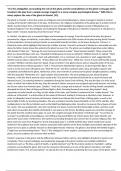“It is the ambiguities surrounding the role of the ghost and the contradictions in the ghost’s message which
transform the play from a simple revenge tragedy to a more complex psychological drama.” With this in
mind, explore the role of the ghost in Hamlet. [45]
The ghost in ‘Hamlet’ is from the outset an ambiguous and commanding figure, whose message to Hamlet is unclear,
causing all of Hamlet’s dilemmas in the play. Furthermore, the religious complexities of the ghost give it another level of
depth, transforming it from a threatening figure to one which highlights the religious turmoil of Elizabethan and
Jacobean England. From the ambiguity surrounding the language of the ghost, to Hamlet’s response to it, the ghost is a
figure which “remains mysterious from first to last” (Frye).
In ‘Hamlet’, the ghost acts as a powerful figure and messenger of revenge. From the outset of the play, the ghost is
presented as a figure of authority, a role which is best presented in the 2009 version of the play starring David Tennant.
In this production, Tennant portrays Hamlet as reverential towards his father, on his knees during Act 1 Scene 5, a
theatrical choice which highlights the hierarchy of father and son. Tennant’s portrayal of Hamlet as a vulnerable son who
obeys his father clearly shows the authority the ghost has over him. The ghost uses multiple imperatives when talking
with Hamlet (“Mark me.” “Revenge his most foul and unnatural murder” Ghost beckons Hamlet). These cement the
ghost as a powerful figure who was “Intended by Shakespeare to have an authority” (William Strunk Jr). Indeed, “Mark
me” is impactful, as it is dramatic, short and authoritative. It is a command, not a question or wish, suggesting that
Hamlet must do what is asked of him, “if thou didst ever thy father love”. While Act 1 Scene 5 starts with Hamlet issuing
an order (“Whither wilt thou lead me? Speak, I’ll go no further”), the ghost returns with an impactful order of his own,
which Hamlet obeys without question (“I will.”). This presents King Hamlet’s ghost as an almost god-like figure. The
scene is on his own terms (the ghost says “Brief let me be” and then continues with a long, descriptive speech) and
completely controlled by the ghost, Hamlet has a few, short remarks in contrast to the ghost’s lengthy speeches, ending
with the impactful “Remember me”, again another short imperative. The most ambiguous part about the ghost
however, is the fact that it seeks to return social order (“Let not the royal bed of Denmark be a couch for luxury and
damned incest”), by ordering Hamlet to completely disrupt the Great Chain of Being. This was the idea of a strict social
order, in which God resided at the top, then the monarch. Below, everyone was assigned rigid social statuses, and acting
out of your status was frowned upon. Claudius’ “most foul, strange and unnatural” murder of King Hamlet completely
disrupted the Great Chain of Being and Divine Right to Rule, throwing Denmark into chaos. King Hamlet’s body
represents not only himself as a King, but the whole of his state, and Claudius’ treatment of him “rankly abused” “the
whole ear of Denmark” is a destruction of the whole of Denmark, leading it to become a disorderly state. However, in
order to (allegedly) return harmony to Denmark, Hamlet must disrupt the Great Chain of Being again, as well as the
Divine Right to Rule, by murdering Claudius. This was a problem faced by Queen Elizabeth I in the 1570s and 80s, after
multiple plots to her life by Catholics such as the Ridolfi and Babington plots, forced her to execute Mary Queen of Scots,
her cousin. This was problematic, since the murdering of a Queen overturned the Divine Right to Rule, and thus could
lead others to question the stability of Elizabeth’s own place on the throne. By killing a queen you send the message to
the public that this could be done again. As such, the vengeful message of the ghost (“I find thee apt” “So art thou to
revenge”) is problematic and ambiguous, since killing a King would likely not restore peace but create disorder and
uproot the social order. Furthermore, the mystery surrounding the ghost also comes from its unclear religious links. The
ghost seems to come from Purgatory (“burnt and purged away”), a wholly Catholic idea, which would have caused
anxiety for the audience due to the violence associated with Catholics at the time (multiple assassination attempts of the
Queen to try to place a Catholic monarch on the English throne). However, the ghost is also linked with hellish imagery
(“sulph’rous and tormenting flames” “fires”). This ambiguity is never explains, and deepens the fear surrounding the
ghost, since the audience do not know what to think.
Hamlet’s response to the ghost, and the differences between father and son, also highlights the ghost’s mystery and
complexity. There is great ambiguity surrounding the language of the ghost. Hamlet uses multiple antithetical
statements such as “Be thou a spirit of health, or goblin damned” and “Be thy intents wicked or charitable”, adding
confusion surrounding the ghost. Not even the characters themselves are sure of the ghost’s intentions, and while
Hamlet later states “It is an honest ghost”, he spends the rest of the play questioning the true nature of the ghost. There




